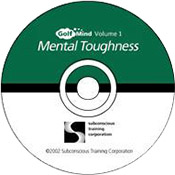 When I heard about the Subconscious Training Corporation and their mental training series for golfers, I knew I had to try it. As a physician and skeptic of the millions of herbal remedies, supplements, and outright snake oil that gets pushed on a gullible public, I was determined to assure that no such quackery made its way into the homes or dented the bank accounts of golf enthusiasts.
When I heard about the Subconscious Training Corporation and their mental training series for golfers, I knew I had to try it. As a physician and skeptic of the millions of herbal remedies, supplements, and outright snake oil that gets pushed on a gullible public, I was determined to assure that no such quackery made its way into the homes or dented the bank accounts of golf enthusiasts.
So, after a thorough review, what is the verdict? To my surprise, I’m here to say that one out of one physician agrees that, while unlikely to turn an uncoordinated chopper into Gene Littler, Golf Mind Software can definitely help your game. That is, if you let it.
Nuts and Bolts
Golf Mind is a two-volume series of mental training exercises for golfers. By “mental training,” we’re not talking about specific advice on course management, club selection, or other in-round decision-making issues often lumped into the category of the “mental game.” Golf Mind has much loftier, far-reaching goals. The program focuses on instilling into our fragile golf psyche a series golf-tailored sports psychology priniciples designed to enhance and maximize athletic performance.
The first volume, Mental Toughness, consists of ten segments on general psychological aspects of golf performance (handling mistakes, focusing, mentally preparing for competition, etc.), the content of which is designed by Fran Pirozzolo, a prominent sports psychologist with an established reputation in golf. Pirozzolo is associated with the Jim McLean golf schools in Florida. Volume Two, Putting Genius, applies the same format to putting-specific training, with Robert K. Winters, an associate of David Leadbetter, as the advising sports psychologist.
The program comes on data CDs that contain a program you watch and listen to on your computer. Each segment lasts about seven minutes. The program is simple to use and the time requirements are not overly taxing. There is no practicing or other machinations required – you simply listen to the lessons eight to ten times and wait to see results in your regular golf game.
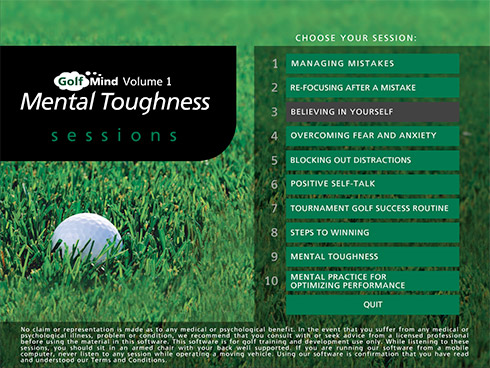
Golf Mind’s functional, if not especially slick or trendy user interface and menu system will have you up and running quickly.
When you pop Golf Mind into your computer and click on your desired lesson, you are greeted by a pleasing female voice and the image of a spinning golf ball. Each segment begins with a three-minute relaxation phase designed to put you in a relaxed, reflective, and hopefully “suggestable,” state of consciousness.
In the ensuing four minutes you hear a series of self-affirmation style statements specifically designed to improve your mental and physical performance in the given area of instruction. For instance, in the “handling mistakes” segment, you will hear things like “I accept that golf is a game of mistakes, and there are no perfect shots,” and in “mental toughness” you will hear about the need for “total committment” to your upcoming shot. After the instructional segment, there is a very brief “wake up” period before the program ends.
That’s it.
Since the program’s visual/audio combination tends to cause a bit of a stir in a busy household (“Daddy’s listening to the lady therapist again”), I opted for some nice headphones and a quiet nook of the house, on a laptop. The female narration is pleasant to listen to, and the words are so direct and personal that in a short time you are really 100% focused on it.
The program can be purchased and additional information obtained at directyourmind.com. The cost is $69 per volume purchased separately, or $108 for the two volume set, a savings of just over 20%.
It Works!
I tried Golf Mind over a two-month period, spending almost all of my time on the “mental toughness” segment of Volume One. My own golf game is remarkably inconsistent, and I thought that this lesson might be the most helpful for me.
Over the years I have found that when playing a round with a scratch or near-scratch golfer, I often play two or three holes where I strike the ball and putt equal to the better man, and that he often has a hole or two where he plays like the chopper that I am. The difference lies in the other 14-15 holes, where I seem to always find some way to lose a stroke or two where the better player does not. One of my low-handicap friends told me he thought many of my errors were ones of concentration and focus, so what better product could there be for me than a lesson on mental toughness?
Well, results certainly were not dramatic or speedy. After using the program as directed for a few weeks, I must admit I noticed absolutely nothing happening in my golf game, except for the fact that I was in a bit of a slump. Then one day I was facing a difficult shot where I had to hit a fairway wood off a downhill lie over a water hazard. The carry was not excessive, but given the lie, I knew that even a minor swing error carried a significant risk of sending the ball into the hazard.
As I went into my pre-shot routine, the idea of taking some relaxing breaths spontaneously entered my mind. I backed off, took the breaths, released the tension in my arms and shoulders, and proceeded to hit the shot reasonably well over the hazard and into the fairway. In similar situations in later rounds, this experience recurred.
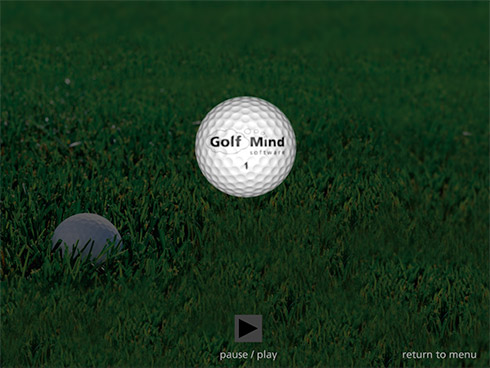
At first you may wonder why you’re staring at a spinning ball and listening to sports psychology clichés, but give it time.
I began to notice over and over that when faced with a difficult or pivotal shot, I would become aware of my emotional state and spontaneously begin to settle myself down. I would occaisionally even “hear” some of the mental suggestions from the program, such as visualizing a positive result, or committing to the shot and not worrying about the result, etc. The first few times this happened, I didn’t immediately think of the Golf Mind program, but finally it dawned on me that, hey, this stuff works. Golf Mind clearly had an effect on my golfing brain.
OK, So it Works… But How, and How Much?
Although you will never hear or see the word “hypnosis” in anything connected with Subconscious Training Corporation products, hypnosis is exactly what it is. While the term hypnosis conjures up all sorts of strange images – maybe Sigmund Freud swinging his pocket watch in your face, his monotone voice droning “YOU ARE GETTINK SCHLEEPY….. SCHLEEEEEEEEEEPEEEEEE” – hypnosis is not anything strange or quackish.
The basic principle is that the human mind can be induced to change chronic thought patterns and behavior by means of mental suggestions made while the patient is in a relaxed, reflective mental state, also known as an “alpha brain wave” state. The precise mechanism of action of hypnosis is debated and not entirely known, but the method is none-the-less accepted as legitimate for treating a variety of mental conditions, including addictions (cigarette smoking), phobias, and other neurotic conditions.
Skeptical of hypnosis when studying it in med school, I personally was convinced that hypnosis was legit when I witnessed my father, a lifetime Camel cigarette smoker, kick the habit with the assistance of a series of hypnosis sessions (he’s now tobacco free for over seven years). Believe me, this was no minor accomplishment, and Dad gives 100% of the credit to the hypnosis.
There are similar, golf-related examples I’m sure many of us can relate to. Who hasn’t had the experience, when attending a tour event, of watching an especially sweet swinger like Fred Couples, and then noticing that the syrupy, rhythmic action carried over, albeit briefly, into our own game? This is, in essence, a form of hypnosis, where our brain reflects on something distinctive and pleasing (in this case an image, not spoken words) and incorporates it into subsequent behavior.
It is by no means a stretch to conclude that something like Golf Mind can affect your behavior, if you are willing to let it work.
But the hundred dollar question remains (well, $108, to be exact), how much will it help, and for how long? I really didn’t notice any significant change in my scoring or overall ball striking, although certainly the relaxation and preparation for the nerve-wracking shots may have avoided a disaster or two. And in so doing, you could argue it made my rounds more enjoyable and rewarding.
Still, could the time and money be better spent taking lessons or practicing chipping and putting? And if I stop listening to the lady therapist, will the benefits die out over time, leading me to revert to my indecisive, defeatest, golf-pathetic self? Well, the time committment was minimal for me (not to mention you can use it at night and in the long, dark winter), and the expense also reasonable, but to be fair, every golfer must answer these question for him or herself. Finally, and this can’t be over emphasized, if the program is to have any chance of success, you have to “buy in” to the idea that sports psychology works and that hypnosis isn’t a crock. Again, every golfer must decide….
A Word to Mac Users (From the Editor)
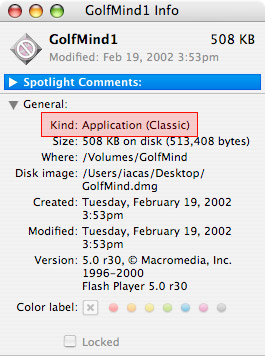 Mac OS X made its debut in March, 2001. Though the first year or two were tough, Apple has since released four more versions and is set to ship a fifth, Mac OS X 10.5 (or “Leopard”) this month.
Mac OS X made its debut in March, 2001. Though the first year or two were tough, Apple has since released four more versions and is set to ship a fifth, Mac OS X 10.5 (or “Leopard”) this month.
What made those first few months rough was the lack of software written specifically for Mac OS X. Most software ran in what’s called “Classic” mode or “Mac OS 9” mode – a legacy backwards support environment that’s not been needed for about four years now. In fact, it hasn’t even been supported for two years.
Which makes Golf Mind’s use of a Classic version of the Flash player application rather frustrating. It simply won’t launch on the majority of Macs running Mac OS X. The work-around is rather simple – drag the “start.swf” Flash file into a browser window and use that to navigate through the ten sessions available.
It works, but c’mon, Subconscious Training Corporation – pony up the cash and buy some software that builds an application playable on computers built this century, wouldja?
The Verdict
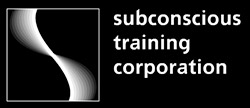 Golf Mind worked for me, and I am sure that it will work for most people who try it and are open to the training concept. If you think psychology and hypnosis are a bunch of you-know-what, don’t waste your money. Also, for those who are interested, I unfortunately don’t really have a sense for how much improvement one can expect, but certainly any sort of mental preparation for golf is better than none at all. And as the comments for Mac users points out, the product could probably be a bit better from a programming standpoint.
Golf Mind worked for me, and I am sure that it will work for most people who try it and are open to the training concept. If you think psychology and hypnosis are a bunch of you-know-what, don’t waste your money. Also, for those who are interested, I unfortunately don’t really have a sense for how much improvement one can expect, but certainly any sort of mental preparation for golf is better than none at all. And as the comments for Mac users points out, the product could probably be a bit better from a programming standpoint.
When you think of it, one thing that is missing or at least under represented in our massive armamentarium of self-help products for golf is a simple, doable program to help you prepare mentally to play. Golf Mind offers this, in a convenient, easy to use package. Any serious golfer who wants to improve his mental preparation for golf is well advised to try the program out.

This is a really cool idea. Maybe I’ll get one.
I can tell you firsthand this is great software! I’ve used it and lowered my scores the next time I went out and played 🙂 !!
Personally, I think you’re better off spending $18 on a Bob Rotella book. 😛
Hello All,
This is Norman Hallett and I’m the CEO at Subconscious Training Corp, the makers of GolfMind Software.
I just wanted to mention that I, too, own Bob Rotella’s book (I got it cheaper because I bought it used!) and it is an excellent book.
The difference between GolfMind and ANY book is that golfmind involves subconscious training, where books effect the conscious mind.
Without going into which is more effective and longer lasting in its effect, I just wanted to suggest that training both the conscious and subconscious minds would result in the maximum positive change.
I look at it as an AND not an EITHER/OR.
THANK YOU to the staff of The Sand Trap for taking the time and effort to review our software.
I used one of the putting exercises and immediately began making putts in bunches. It hasn’t lasted, but my useage was somewhat erratic.
My only question (I have both discs) is about the exercise regimen. Should I simply listen to one exercise on each disc everyday – alternating lessons so there is a rotation – or should I simply pick one and stick to it everyday?
Seeker: I think the recommendation is to focus on one excercise for a while, then move on. It’s 3x/week minimum for about 2 weeks, I believe, but the instructions that come with the package should spell this out.
Glad to hear it worked for you!
What is the name of the female person who is the voice on the software? She’s good but Roseanna Leaton who produces GolferWithin CD’s is better. I’ve tried both and Roseanna is much easier for me to listen to. She tends to not be as redundant.
Norman Hallett here, CEO of Subconscious Training Corp., makers of GolfMind Software, responding to Dr. Hughes’ question.
The voice on the software is my wife and Creative Director of the firm, Tisha Hallett. She is known in the subconscious training community, not only for her work in the field, but specifically for the quality of her voice.
I’ve never heard the voice on the CD you mentioned, but I’m sure it’s good. I find that “liking a voice” is based on a lot of things… mostly individual preference. We’ve had dozens of comments on how much people love Tisha’s voice, as well as one comment I recall that said, “I can’t stand listening to her. She sounds just like my ex-Wife!”
To comment on you mention of redundency, the repetition of the core suggestions is very important, and my seem redundant, especially on the first few trainings.
The training on GolfMind Software are only 7-minutes long… much shorter than any training that we know as available on the market today. (my guess is that the other CD you mentioned had a training that was considerably longer). The fact that keeping the sessions VERY short (and there for more Do-Able for people… easier for the trainee to commit to doing) means that the core suggestions have to be mentioned more often in the shorter time space (not much room for “secondary” suggestions).
Part of the great success with GolfMind Software, both from our standpoint (selling the product) and the customer’s standpoint (using the product), is the fact a session only takes 7 minutes to complete. This means that a customer can more easily commit to doing the trainings and therefore get the results.
Happy New Year to all!
Norman Hallett